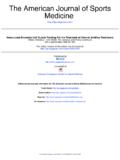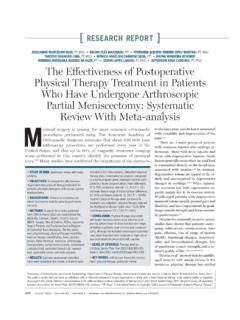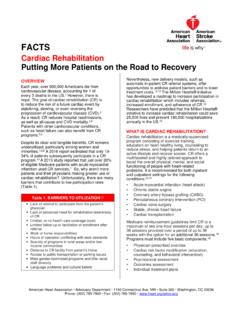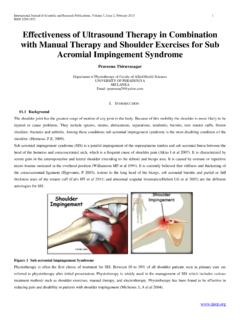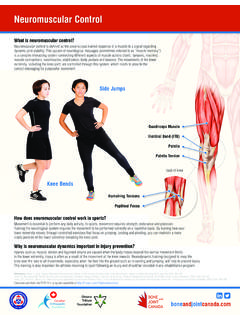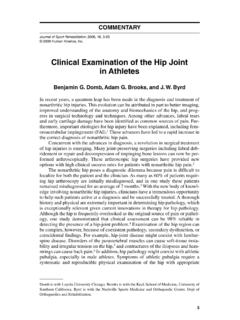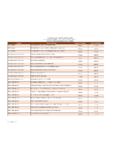Transcription of PREVENTION OF REINJURY USING LENGTHENED …
1 The International journal of sports Physical Therapy | Volume 7, Number 3 | June 2012 | Page 333 ABSTRACTBack ground and Purpose: Hamstring injury is a common occurrence in sport and there has been limited success in reducing this rate of recurrence to date. Description of Topic with Related Evidence: High speed running requires eccentric strength when the hamstring muscles are in a LENGTHENED state. The LENGTHENED state occurs when the hip is in flexion and the lower leg moves into extension, thus lengthening the two joint hamstring muscle over both articula-tions upon which they act.
2 There is evidence to suggest that athletes who have sustained a hamstring strain lack strength when the muscle is utilized during performance in a LENGTHENED : To examine the risk factors contributing to such a high recurrence rate and propose a unique rehabilitation strategy addressing these factors in order to decrease the rate of to Clinical Practice: Failing to increase an athlete s eccentric strength in a length-ened position after a hamstring injury may predispose an athlete to subsequent REINJURY . Incorporating LENGTHENED state eccentric training may help reduce the rate of words: Hamstring strain, LENGTHENED state eccentricsLevel of Evidence: Level 51 PRO sports Physical Therapy of Westchester, Scarsdale, NY, USA2 Nicholas Institute of sports Medicine and Athletic Trauma, Lennox Hill Hospital, New York City.
3 NY, USAIJSPTCLINICAL COMMENTARYHAMSTRING INJURY REHABILITATION AND PREVENTION OF REINJURY USING LENGTHENED STATE ECCENTRIC TRAINING: A NEW CONCEPT Brandon Schmitt, DPT, ATC1 Tim Tyler, PT, ATC1,2 Malachy McHugh, PhD2 CORRESPONDING AUTHORB randon Schmitt, DPT ATCPRO sports Physical Therapy of Westchester 2 Overhill RoadSuite 315, Scarsdale, NY International journal of sports Physical Therapy | Volume 7, Number 3 | June 2012 | Page 334 BACKGROUND AND PURPOSEH amstring strains are one of the most frequently occurring injuries in sport.
4 They can be challenging and frustrating to treat because of the high recur-rence rate. Hamstring strains account for 12-16% of all injuries in athletes1-5 with a REINJURY rate reported as high as 22-34%.5-7 Furthermore, recurrent ham-string strains have been shown to result in signifi-cantly more time lost than first time hamstring In order to decrease this rate we must first examine the potential risk factors for injury and then address them accordingly. While there is a myriad of studies focusing on risk factors for hamstring strains.
5 There is a paucity of high-level evidence with regards to the identification of these risk factors as well as rehabilitation with an emphasis on reducing the risk of The purpose of this clinical commen-tary is to examine the risk factors contributing to such a high recurrence rate and propose a unique rehabilitation strategy addressing these factors in order to decrease the rate of FACTORS FOR HAMSTRING STRAINSS everal risk factors for hamstring strains have been proposed in the literature, including: decreased flexi-bility,9-10 strength deficits,11 muscle fatigue,12 poor core stability,13 lack of proper warm-up,14 poor lum-bar posture,15 and a prior hamstring ,17 Previ-ous hamstring injury appears to be the most consistent risk factor for restraining the hamstring.
6 Engebret-sen et al17 examined over 500 amateur soccer players prospectively and among all the risk factors exam-ined, previous acute hamstring strain was the stron-gest risk factor for recurrent strain. In fact, a previous hamstring strain has been shown to increase the risk of a recurrence two to six MECHANISM OF INJURYH amstring strains can occur during a variety of ath-letic maneuvers and situations, resulting in several distinct types of injuries, each with a unique mecha-nism. The first occurs during a stretching of the mus-cle at extreme joint positions, such as in a Rockette style high These injuries generally occur to the proximal free tendon of the semimembranosus tendon and appear to be less severe initially but ulti-mately require a longer recovery time than ham-strings strained by other The second mechanism of hamstring strain occurs during high speed.
7 22 There remains some debate in the literature as to which phase of the sprinting cycle in which hamstring strains occur: the early stance phase or the late swing phase. Proponents of hamstring injury during early stance phase of sprinting suggest it is during this phase in which the muscle absorbs the most force as a result of high ground reaction In vivo studies of the Achilles tendon in sprinting24 and patella tendon in jumping25 and hopping26 show that the forces are much higher in the concentric stance phase as opposed to the eccentric swing phase and this may apply to the hamstrings as well.
8 There is also evidence to suggest hamstrings may be suscepti-ble to injury in the late swing phase. Previous studies demonstrate that the hamstrings are under a large amount of stress in the terminal swing phase as the hamstrings eccentrically contract to absorb the kinetic energy and slow the lower In a biomechanical study Schache et al28 found that peak musculoten-donous strain occurred during terminal swing phase of the sprinting cycle, suggesting that this period may pose the greatest risk for injury. They went on to rec-ommend a rehabilitation program focusing on eccen-tric loading at longer muscle lengths.
9 To assess whether a reduction in force production at longer muscle lengths exists in athletes who have sus-tained a hamstring strain, Brockett et al29 examined the angle torque curves of previously injured subjects and compared them with the subjects uninvolved leg as well as those of uninjured control subjects. The authors showed that the peak hamstring torque occurred at a significantly shorter muscle length in the previously injured hamstring when compared to controls, indicating what may be termed a shift in the length-tension curve.
10 It is possible that when an ath-lete sustains a hamstring strain they potentially return to play with weakness at longer muscle lengths possi-bly predisposing them for a second hamstring strain during the eccentric terminal sprinting movement. It has been well established in the literature that eccentric training is effective in the PREVENTION of hamstring ,30-33 The authors feel that the eccen-tric training should be done not just in the seated posi-tion from 90 degrees to full knee extension, but should include training in the LENGTHENED state.


